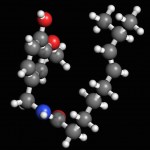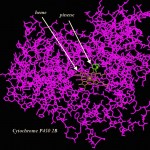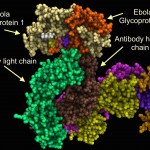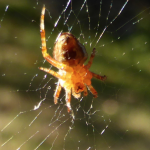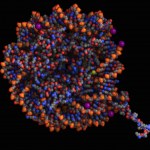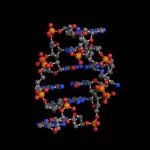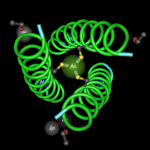MMDB
To have an effect, a molecule must bind to a receptor and trigger a signal. Studying a receptor's structure can give us insights about the way this triggering process works.
Capsaicin is a fascinating molecule that puts the "pep" into peppers. Curiously, the amount of capsaicin in a pepper is measured with a test devised in 1912 by Wilbur Scoville. Dried peppers are dissolved in alcohol, this liquid extract is diluted in water, and trained people determine the pepper's Scoville value by "tasting" the heat.
I wonder how these people are recruited. I like hot sauce but I can't imagine…
On pinene and inhibiting enzymes.
People of a certain age may remember a series of really funny commercials featuring Euell Gibbons and his famous question about whether you've ever eaten a pine tree. "Some parts are edible" said Euell.
Perhaps some parts are, but other pine tree products aren't so nourishing. Crystallography365, aka @Crystal_in_city had a couple of fun blog posts about pinene, a chemical made by pine trees, that also inhibits cytochrome P450 2B6.
I was inspired by their posts and by my experience with Cytochrome P450 to go a little farther. We like to use cytochrome…
Sucrose
Molecules of sucrose tore apart in their bellies letting glucose course free in their veins.
Luckily for us, a system evolved long ago to capture that glucose and minimize it's potential for damage. Removing sugar from the blood and sequestering it in liver, fat, and muscle cells, minimizes the harm that might result if sugars were free to bind to proteins and our bodies were stressed by trying to flush excess glucose out of our system.
This holiday season, we give thanks for insulin and the biotech companies like Genentech that cloned the human gene and began to produce this…
In 1925, dogsledders raced through the frozen Alaskan bush to bring antiserum to the isolated village of Nome. The antiserum arrived in time, saved the lives of many villagers from the horrors of diphtheria, and inspired the Iditarod, a famous race in celebration of the dog sledders' heroic feat.
West Africa could use a similar effort today. Richard Harris's blog at NPR has a good story about doctors' efforts to develop and use antiserum to treat Ebola. According to ABC news, Dr. Kent Brantly, who is being seen at Emory University Hospital was treated with antiserum as was the other aid…
What’s the first you think about when you see a spider? Running away? Danger? Fairies? Spiderman?Do you wonder if spider silk is really strong enough to stop a train, like they showed in Spiderman 2?
Whatever your thoughts, you’re probably not thinking about 3D printing in space. Yet, the time might be near when astronauts will be using 3D printers filled with spider silk to make replacement parts in space. I learned about this idea in a presentation from Dr. Ron Sims, Utah State University, at the Bioman conference at Salt Lake Community College a couple of weeks ago.
Spider silk, as I…
A key concept in science is molecular scale. DNA is a fascinating molecule in this regard.
While we cannot "see" DNA molecules without the aid of advanced technology, a full length DNA molecule can be very long. In human cells, other than sperm and eggs, six billion base pairs of DNA are packaged into 22 pairs of chromosomes, plus two sex chromosomes. Each base pair is 34 angstroms in length (.34 nanometers, or ~0.3 billionths of a meter), so six billion base pairs (all chromosomes laid out head to toe) form a chain that's two-meters long. If we could hang this DNA chain from a hook, it would…
Today (4/25) is national DNA day. Digital World Biology™ is celebrating by sharing some of our favorite structures of DNA. We created these photos with Molecule World™ a new iPad app for viewing molecular structures.
As we are taught in school, the double stranded DNA molecule is a right-handed helix as determined by Watson and Crick using Franklin's x-ray diffraction images [1]. This B-form of DNA has approximately 10 nucleotides per turn of the helix and is the most common form of DNA found in nature.
Classic structure with the elements colored.
Classic structure with the bases…
It's been interesting to watch as microbiology's own cold fusion debate has been raging. It began with an extraordinary claim about bacteria using arsenate as a replacement when phosphate concentrations are low (1).
It progressed when at least two scientist / bloggers ( here, and here) (not bloggers! the horrror! how uncivil!) gave public "journal club" presentations on blogs (envision dripping slime).
It continued with the science journalists lamenting about having swallowed the hype.
And it seemingly ended with another scientist / blogger's post that seemed to equate discussions of …
Want to learn more about Parkinson's disease? See why a single nucleotide mutation messes up the function of a protein?
I have a short activity that uses Cn3D (a molecular viewing program from the NCBI) to look at a protein that seems to be involved in a rare form of Parkinson's disease and I could sure use beta testers.
If you'd like to do this, I need you to follow the directions below and afterwards, go to a web form and answer a few questions. Don't worry about getting the wrong answers. I won't know who you are, so I won't know if you answered anything wrong.
If you have any concerns…
Lots of bloggers in the DNA network have been busy these past few days writing about Google's co-founder Sergey Brin, his blog, his wife's company (23andme), and his mutation in the LRRK2 gene.
I was a little surprised to see that while other bloggers (here, here, here, and here) have been arguing about whether or not the mutation really increases the risk to the degree (20-80%) mentioned by Brin, no one has really looked into the structure and biochemistry of the LRRK2 protein to see if there's a biochemical explanation for Parkinson's risk. I guess that task is up to me.
Let's begin at…
One of the things that drives me crazy on occasion is nomenclature. Well, maybe not just nomenclature, it's really the continual changes in the nomenclature, and the time it takes for those changes to ripple through various databases and get reconciled with other kinds of information. And the realization that sometimes this reconciliation may never happen.
One of the projects that I've been working on during the past couple of years has involved developing educational materials that use bioinformatics tools to look at the isozymes that metabolize alcohol. As part of this project, I've been…
Instead of enjoying a sunny summer day today, or partying with SciBlings in New York, I'm staring out my window watching the rain. Inspiration hit! What about searching for August?
Folks, meet the HFQ protein from E. coli. I found this lovely molecule by doing a multi-database search at the NCBI with the term 'August'.
HFQ is a lovely protein with six identical subunits, that's involved in processing small RNA molecules and is homologous to some eucaryotic proteins that work in RNA splicing (1).
Do you see the blue loopy regions in the center of the structure? Those are positively…
Over 2600 genetic diseases have been found where a change in a single gene is linked to the disease. One of the questions we might ask is how those mutations change the shape and possibly the function of a protein?
If the structures of the mutant and wild type (normal) proteins have been solved, NCBI has a program called VAST that can be used to align those structures. I have an example here where you can see how a single amino acid change makes influenza resistant to Tamiflu®.
This 4 minute movie below shows how we can obtain those aligned structures from VAST and view them with Cn3D.…
